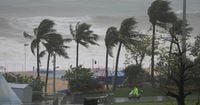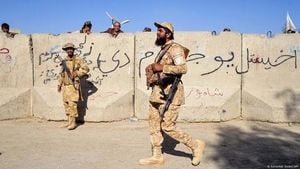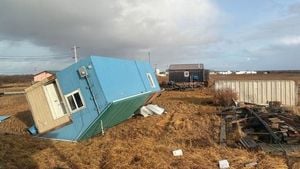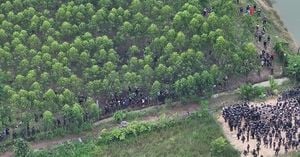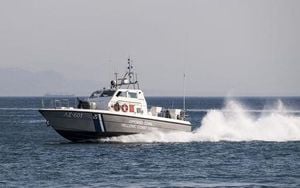More than 300 communities across central and eastern Mexico remain isolated in the wake of catastrophic flooding and landslides, as rescue teams work around the clock to reach survivors and restore crucial infrastructure. The death toll, as confirmed by Mexican authorities on October 14, 2025, has climbed to at least 64, with another 65 people still missing, underscoring the scale and urgency of the ongoing disaster response.
The crisis unfolded after torrential rains, triggered by a rare convergence of two tropical storms off Mexico’s western coast, battered the region for several days last week. According to the Associated Press, the deluge struck at the tail end of an exceptionally heavy rainy season, causing rivers to overflow and hillsides to give way. The resulting landslides and floods have devastated small towns—many with populations of just 500 to 1,000—leaving their fate uncertain as officials struggle to access the hardest-hit areas.
“Reopening roads is one of our greatest urgencies,” President Claudia Sheinbaum told reporters on Monday. “We have to secure air bridges, food supplies, water, and check on how each person is faring.” Her remarks, echoed across multiple briefings, highlight the logistical nightmare facing authorities: hundreds of communities remain cut off, some only reachable by helicopter, while thousands of soldiers and civilian workers scramble to clear debris and restore access.
The worst devastation has been reported in the states of Veracruz, Hidalgo, and Puebla. In Hidalgo, about 100,000 homes have been either damaged or destroyed by the relentless flooding and mudslides, according to early official estimates cited by the Business Standard. In Veracruz alone, rainfall reached a staggering 24 inches over just four days, leaving at least 29 dead and affecting more than 300,000 people. The Civil Protection agency has also confirmed 21 deaths in Hidalgo and 13 in Puebla, with a child tragically killed in a landslide in Querétaro.
In Poza Rica, a city in Veracruz, the Cazones River surged to 13 feet (4 meters) in some neighborhoods. Roberto Olvera, a resident, described the harrowing moment an oil refinery alarm signaled the rising waters. “It was terrifying, many people in the neighborhood couldn’t escape,” he told the Associated Press. The floodwaters left behind a black, oily residue—believed to have come from nearby oil and gas installations—that coated trees and rooftops, compounding the environmental and health hazards facing survivors.
Healthcare infrastructure has been hit hard. Dozens of health centers have been damaged or rendered unusable. In Álamo, Veracruz, floodwaters rose to two meters (6.5 feet), destroying all medical equipment. Local health director Martí Batres reported that medical staff are now forced to work outdoors, improvising care for those injured or sickened during the disaster. To prevent disease outbreaks such as dengue—a mosquito-borne illness—health teams have begun fumigating affected areas.
For those trapped in remote villages, daily life has become a struggle for survival. Residents in isolated communities, such as Tenango de Doria in Hidalgo, have been seen trekking for hours through mud and debris in search of food and water. “We walked two-and-a-half hours through the mud...Everything is completely undone; we have no supplies, no food, nothing,” Marco Mendoza, a 35-year-old farmer, told AFP. Stores in the area have been left without electricity, and crowds have gathered in central plazas, desperate for news about road openings and the arrival of aid.
The government’s response has been swift but complicated by the sheer scale of the disaster. President Sheinbaum announced that around 10,000 troops have been deployed with boats, planes, and helicopters to deliver critical supplies and conduct rescue operations. Shelters have been opened for those displaced, and private construction firms are assisting with the reopening of major roads. Helicopters have become lifelines, ferrying food and water to communities that remain inaccessible by land. “Many flights are needed...to deliver enough food and water,” Sheinbaum noted during Monday’s press conference.
Despite the overwhelming challenges, Sheinbaum has repeatedly assured the public that the government has sufficient resources to respond. “There are sufficient resources, this won’t be skimped on ... because we’re still in the emergency period,” she said, promising a rapidly scaled-up response. The president also addressed concerns about early warning systems, emphasizing the difficulty in predicting this particular event. “It would have been difficult to have information in advance about this situation, unlike what happens with hurricanes,” she explained, pointing to the unpredictable combination of a tropical system from the Gulf of Mexico and a cold front from the north that fueled the historic rainfall.
As the weather cleared in some regions on Sunday, heavy machinery was finally able to begin clearing debris, opening the way for more comprehensive relief efforts. Still, the full extent of the devastation remains unclear, especially in remote towns that have been entirely cut off for days. Civil Defense Coordinator Laura Velázquez Alzá warned that it could still be days before access is restored to every affected community, noting that 80 communities in northern Veracruz alone remained inaccessible by road as of Monday.
The human toll is only now coming into focus. In addition to the confirmed deaths and missing persons, tens of thousands are displaced, with homes and livelihoods swept away. The scale of destruction spans at least five states, with some houses near rivers “practically disappeared,” as President Sheinbaum described after visiting affected communities in Puebla and Veracruz.
Environmental hazards add another layer of complexity to the crisis. In Poza Rica and other oil-producing regions, the oily residue left by the floods raises concerns about water contamination and long-term health effects. Meanwhile, the destruction of healthcare facilities and infrastructure has left many without access to basic medical services, further endangering vulnerable populations.
As rescue and recovery operations continue, the government faces the daunting task of not only restoring access and providing immediate relief but also addressing the long-term needs of communities whose lives have been upended. For now, the focus remains on reaching the isolated, caring for the injured, and preventing further tragedy as Mexico grapples with one of the worst natural disasters in recent memory.
The coming days will test the resilience of both authorities and survivors, as the nation pulls together to confront the aftermath of a disaster whose true scope is still being revealed with each passing hour.
